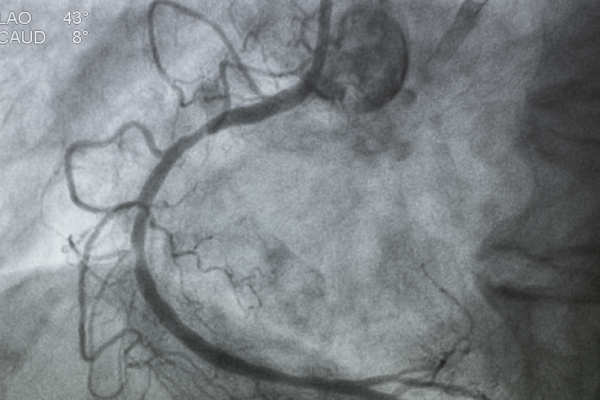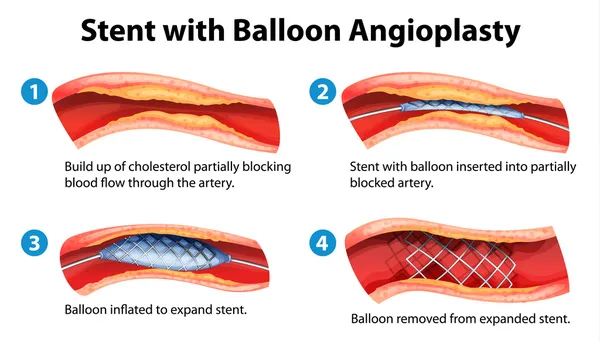Procedures
Coronary Angiography & Stenting
Coronary Angiography
Coronary angiography is considered the “gold standard” method for evaluating narrowed or obstructed blood vessels that supply heart muscle. It is a minimally invasive procedure performed in hospital under light sedation and local anaesthesia, ensuring maximum comfort and convenience for the patient.
During the procedure, a thin tube is inserted through a blood vessel, either at the wrist or the top of the leg. A catheter is then threaded through the sheath to the coronary arteries, allowing for a detailed assessment of any blockages or narrowings. The coronary arteries are visualised with X-ray guidance, and moving images of the arteries from various angles are captured through the injection of contrast.
This procedure provides essential information that is critical for effective diagnosis and treatment of coronary heart disease, making it an invaluable tool in modern cardiology. You can elect to have this procedure done in a public or private hospital.
In the event of the discovery of a significant narrowing or blockage, you may be advised to proceed directly to angioplasty and stenting. This will be discussed with you prior to the procedure. In cases where the decision to stent is not straightforward, we will stop the procedure and discuss treatment options with you in our rooms at a later date.

Stenting
A critical aspect of treating significant coronary artery blockages is the use of angioplasty and stenting, a minimally invasive procedure. During the procedure, a specialised tube is inserted into the relevant artery using the same sheath as the angiogram.
A thin wire is then carefully guided into the artery, across the blockage, and a small balloon is advanced over the wire to the narrowed area. The balloon is then inflated, which causes the stenosis to widen and the blood flow to improve. To keep the artery open, a small mesh-like cylinder called a stent is placed at the site of the blockage. Once the procedure is completed, the balloon is removed, and the stent is left permanently in place to maintain the arterial blood flow.
Prof Sanjay Patel is an experienced high volume coronary operator, with specific expertise in complex coronary interventions and coronary physiology and intra-coronary imaging to both optimise diagnosis of significant coronary disease in the catheter lab and post-stenting outcomes. He is accredited to perform coronary angiography/stenting at RPAH, MUH and the Mater Hospitals.

Call for Appointment
(02) 9646 4044
Procedures Expertise
Electrophysiology Study and Catheter Ablation
Before Stenting
After Stenting
Everything you need to knowabout
Coronary Angiography & Stenting
What is a Coronary Angiography?
A Coronary Angiography is a diagnostic test that uses X-rays to examine the blood vessels of the heart (coronary arteries) for blockages or narrowings.
What is a Pressure Wire Assessment?
This is a diagnostic test performed at the time of coronary angiography to determine whether moderate narrowings should be stented or whether the small coronary vessels (microcirculation) are diseased.
What is Intra-Coronary Imaging?
This involved placement of a specialised imaging catheter (using either ultrasound or light waves) into the coronary vessel to directly image inside the vessel. This ensures the stent chosen to treat the narrowing is matched precisely to the size of the vessel.
What is a Stent?
A stent is a tiny metal mesh tube that is inserted into the narrowed or blocked artery during an angioplasty to help keep it open.
What preparation is required before Coronary Angiography?
Before the procedure, a blood test will be required, and fasting is sometimes necessary on the day of the test. It is essential to inform your cardiologist if you have previously had a reaction to contrast (X-ray dye) to ensure the appropriate precautions are taken. Your cardiologist may advise you to take specific blood-thinning medication in preparation for the procedure, and unless instructed otherwise, you should continue taking your regular medications.
How is a Coronary Angiography performed?
A Coronary Angiography is performed under light sedation and local anaesthesia. A thin tube (catheter) is inserted into a blood vessel either at your wrist or at the top of your leg. The catheter is then threaded up to the coronary arteries under X-ray guidance.
What are the risks associated with Coronary Angiography & Stenting?
As with any medical procedure, there are risks associated with Coronary Angiography & Stenting. Your doctor from the Auburn Cardiology team will discuss the risks and benefits of undergoing this procedure prior to scheduling your procedure.
How long does the procedure take?
The procedure typically takes between 30 minutes to an hour to complete, but this can vary depending on specific patient situations. You should expect to spend about 6 hours at a hospital for preparation, the procedure itself, and post-procedure observation.
Will I need to stay overnight in the hospital?
In most cases, the procedure is done on an outpatient basis, meaning you will not need to stay overnight in the hospital. However, patients who undergo angioplasty and stenting are usually required to stay 1 night in hospital.
What can I expect during the recovery period?
You will need to rest for several hours after the procedure to allow the sedative to wear off and to make sure there are no complications. You will be monitored for any signs of bleeding or other complications, and your cardiologist will let you know when it is safe to go home. You may experience some soreness or bruising at the insertion site, but this should go away within a few days. You will need to avoid strenuous activities and heavy lifting for several days to a week after the procedure. Your cardiologist will give you specific instructions on how to care for yourself during the recovery period.
Call for Appointment
(02) 9646 4044
Procedures Expertise
Electrophysiology Study and Catheter Ablation
Book an Appointment
Call for appointment/GP referral
(02) 9646 4044
